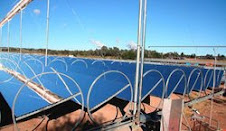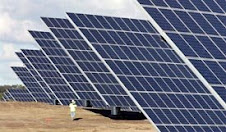Putting the bite on C02
from www.TheStar.com - Business
One way to reduce climate-change-causing gas is to serve it up and let algae do its stuff
July 23, 2007 - Tyler Hamilton, Business Reporter
Capturing carbon dioxide can be done in several ways, but the most unusual approach by far is to literally feed the greenhouse gas to CO2-hungry algae.
Several companies have attempted over the years to develop algae bioreactor systems that can be attached to coal- or natural gas-fired power plants or big industrial facilities. The idea is that CO2 emissions from these operations can be directed to an algae "farm," where the tiny organisms feast on the gas until they're fat enough to harvest.
The mature, oil-rich algae can then be processed into a number of products, such as biodiesel, ethanol, animal feed and a variety of plastics. So you end up with a double benefit: keeping CO2 from entering the atmosphere, and producing renewable products that can reduce the need for fossil fuels.
But like most dream technologies, CO2-to-algae-to-oil systems would be great if designing them didn't present so many challenges.
Last month, Cambridge, Mass.-based GreenFuel Technologies, a leading developer of algae-to-biofuel systems, found that a pilot system it had built in Arizona was growing algae so aggressively that it couldn't harvest them fast enough. As a result, the algae began to die.
The company also found out that the cost of its next-generation system was twice as much as it originally calculated, so it was forced to shut down the Arizona pilot and lay off nearly half of its staff.
This doesn't bode well for business. Power utilities, normally a conservative bunch, tend to shy away from any technology that isn't rock solid and risk free. They want to see more trial and less error.
As for a developing such systems for the Canadian market, experts say the cooler weather in Canada would make it difficult to keep the algae farms alive and productive year-round.
But never say never. The federal government announced in March that it was contributing $100,000 toward the first phase of a project to design microalgae systems with the potential to "capture up to 100 million tonnes of CO2 from industrial sources," the government said.
Not a huge contribution, but at least it kick-starts some serious research.
It's the first project under the newly created I-CAN Centre for the Conversion of Carbon Dioxide, which will be co-led by government research centres in Alberta, Saskatchewan, Manitoba and Quebec.
And earlier this month, a consortium of academics, scientists and businesses threw their hat into the algae pond, describing their collective goal of building a commercial "photo bioreactor" within three years and designing it for the needs of the Canadian market.
One company in that consortium is Ottawa-based Menova Energy Inc., which in other circles is known as a provider of solar hybrid systems that can provide both heat and electricity to schools, industrial facilities and other large buildings.
Another is Trident Exploration Corp., a natural gas exploration company looking at ways to reduce its CO2 emissions.
Menova president Dave Gerwing says Trident knew it was only a matter of time before the federal government began imposing penalties on CO2 emissions. Trident approached a number of companies looking for solutions, including GreenFuel Technologies, but it ended up teaming up with Menova last year.
So what does a solar company have to do with carbon sequestration in algae?
Gerwing, a determined engineer, says it's a combination of innovation and better economics. What Menova brings to the table that other companies don't is a combination of heat and light – both of which are crucial ingredients to algae cultivation.
Menova's Power-Spar system uses solar concentrators to focus the sun on photovoltaic solar cells, which produce electricity, and fluid-filled channels that capture the sun's heat. But the system goes one step further, capturing the sunlight and redirecting it where necessary through fibre-optic cables.
What this means is that an algae farm – or what Menova calls its "photo bioreactor" – can be designed in a way where heat and light are concentrated in a relatively more confined area, allowing for the high-density growth of algae without the need for acres and acres of land.
"Our initial estimates are that we're going to be able to recycle 100 to 150 tonnes of greenhouse gases into biomass a year, then convert it into biofuel, based on 70 square metres of collector area."
Keeping a constant temperature is key, Gerwing points out. "We've figured out a way to make stuff stay at 70-degrees C when outside it's minus 30C," he says. "It's something you can do all year, meaning you don't make green popsicles out of algae (in the winter)."
On top of this, any algae system using Menova's collectors can produce electricity that can be sold into the grid or, in the case of Trident, used for their own power needs.
Suddenly the economics, compared to other models on the market, begin looking attractive – even in Canada. Companies that purchase such a system can earn revenues generating electricity, producing raw material for making fuels and other bioproducts, and selling carbon credits into cap-and-trade markets.
In fact, Trident and Menova expect the system will reduce by half the amount of carbon emissions resulting from petroleum processing – welcome news, if do-able, to producers in the oil sands.
The pilot project is expected to begin shortly, and a working commercial system is being targeted for 2010.
Other consortium members include the National Research Council, Olds College School of Innovation-Biofuel and Technology Centre, and the University of Saskatchewan.
The photo bioreactor technology is currently in the process of being patented, so Gerwing wouldn't go into further detail about how the technology works. This, however, doesn't hide his excitement.
"I don't sleep much," he says. "If you saw some of the stuff on the drawing board ... it's just so rewarding."
Canada may be late in this race, but the Menova-Trident project, if successful, could quickly put us ahead of the pack.






No comments:
Post a Comment